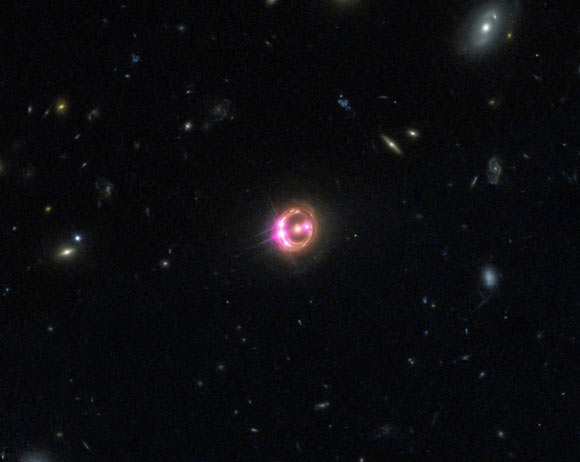Using a quasar microlensing technique, astronomers claim to have found a large population of unbound planets — with masses ranging from Moon to Jupiter mass — in the foreground galaxy of the strong lensing system RXJ 1131-1231.

Image of the gravitational lens RX J1131-1231, with the foreground elliptical galaxy at the center and four images of the lensed quasar. It is estimated that there are trillions of planets in the lens galaxy. Image credit: University of Oklahoma.
RXJ 1131-1231 is a quasar-galaxy lensing system, where a background quasar is gravitationally lensed by a foreground galaxy and multiple images of the quasar form.
Light from these quasar images crosses different locations of the foreground galaxy, and is further lensed by nearby stars in the region in the lens galaxy. This effect is called quasar microlensing.
“Using quasar microlensing, we were able to detect free-floating objects in the RXJ 1131-1231 lens galaxy that range from the mass of the Moon to the mass of Jupiter,” said University of Oklahoma astronomers Professor Xinyu Dai and Dr. Eduardo Guerras.
The researchers made the discovery with the data from NASA’s Chandra X-ray Observatory.
“We are very excited about this discovery. This is the first time anyone has discovered planets outside the Milky Way,” Professor Dai said.
“These small planets are the best candidate for the signature we observed in this study using the microlensing technique.”
“We analyzed the high frequency of the signature by modeling the data to determine the mass.”
While planets are often discovered within the Milky Way using microlensing, the gravitational effect of even small objects can create high magnification leading to a signature that can be modeled and explained in other galaxies.
“This is an example of how powerful the techniques of analysis of extragalactic microlensing can be,” the scientists said.
“This galaxy is located 3.8 billion light years away, and there is not the slightest chance of observing these planets directly, not even with the best telescope one can imagine in a science fiction scenario,” Dr. Guerras said.
“However, we are able to study them, unveil their presence and even have an idea of their masses. This is very cool science.”
A paper reporting this discovery is published in the Astrophysical Journal Letters (arXiv.org preprint).
_____
Xinyu Dai & Eduardo Guerras. 2018. Probing Planets in Extragalactic Galaxies Using Quasar Microlensing. ApJL 853, L27; doi: 10.3847/2041-8213/aaa5fb







